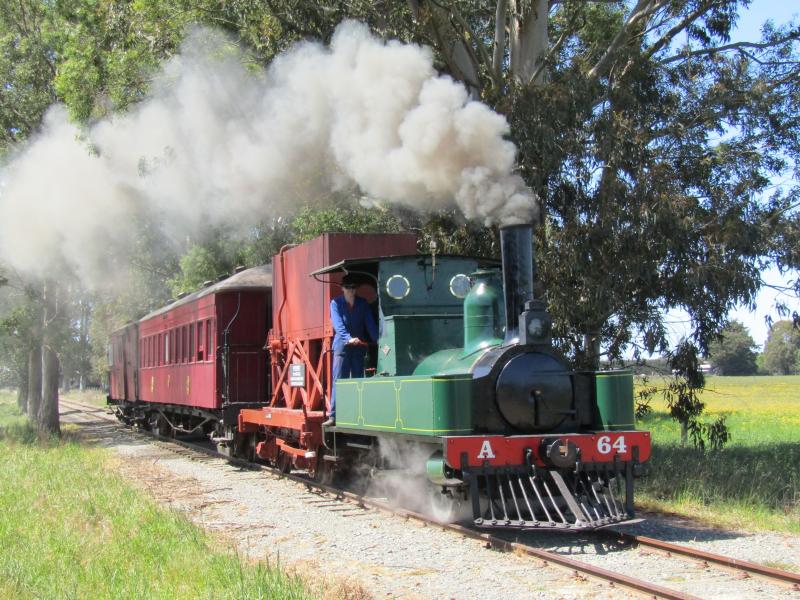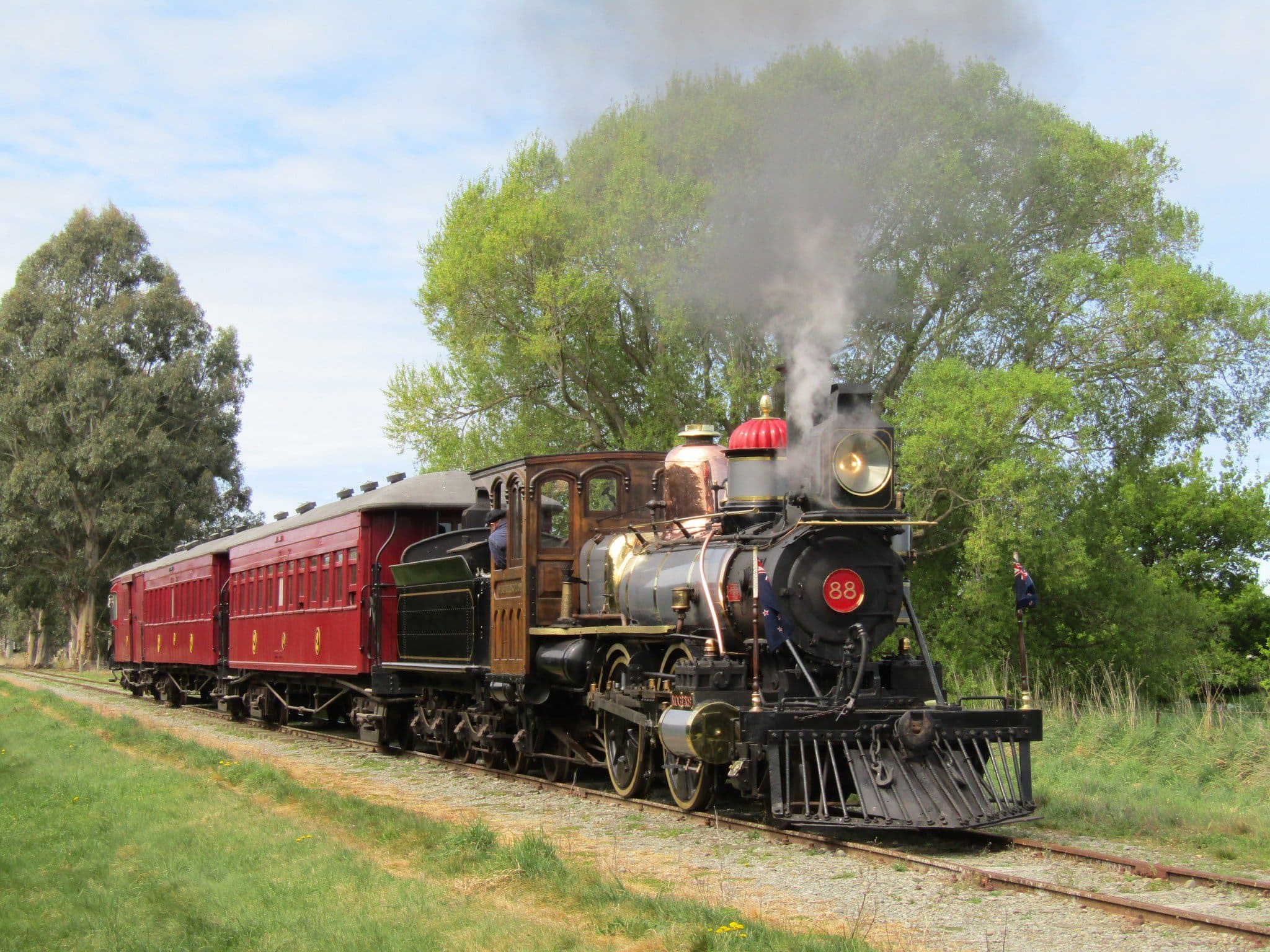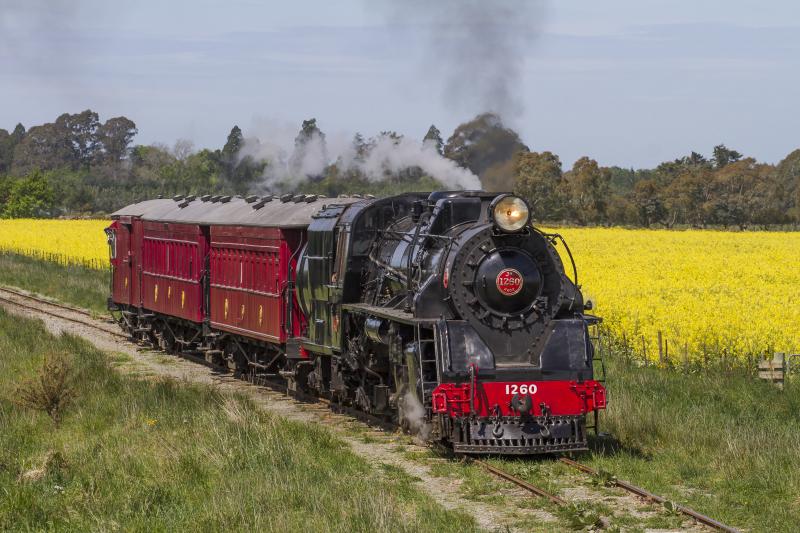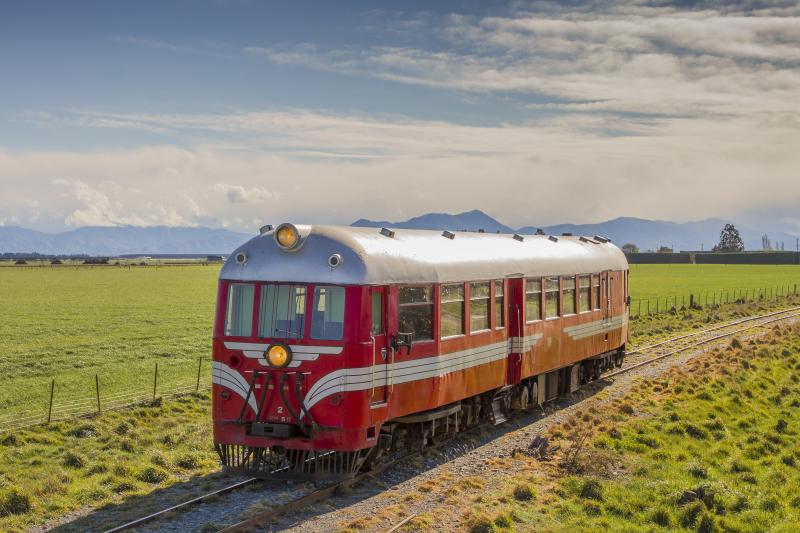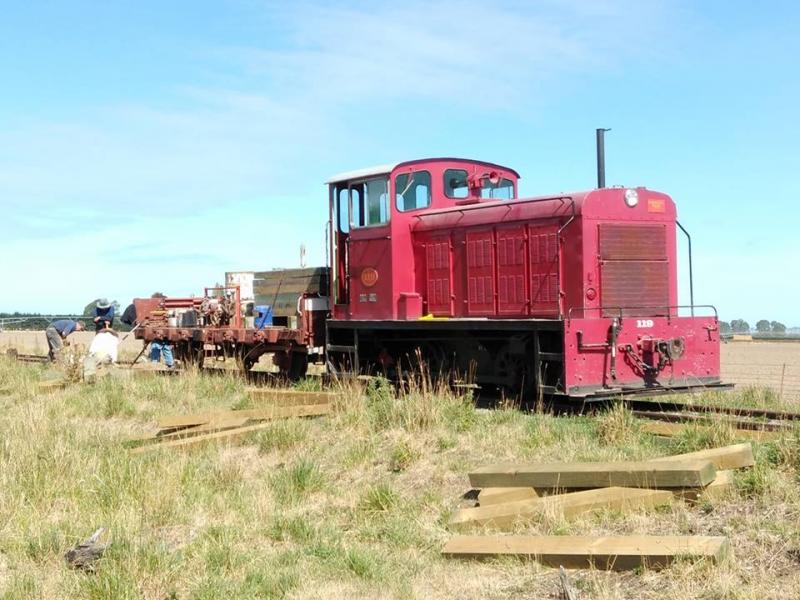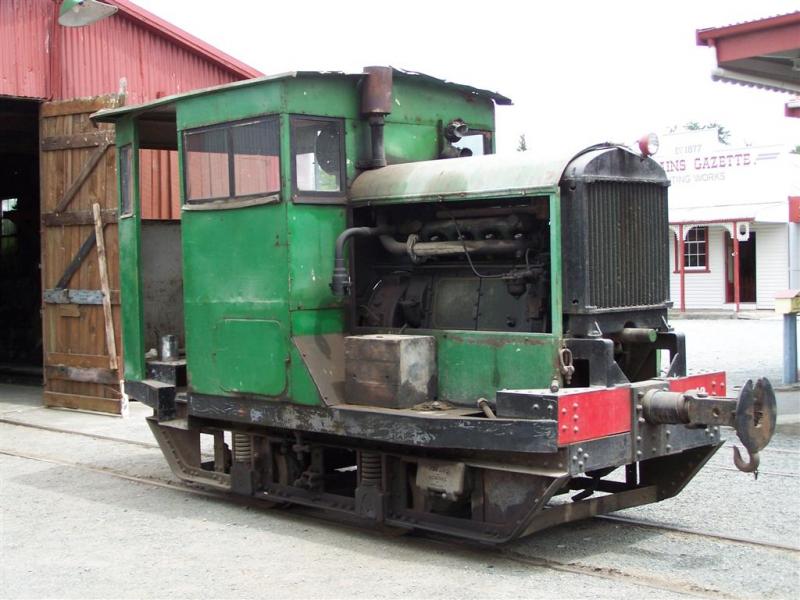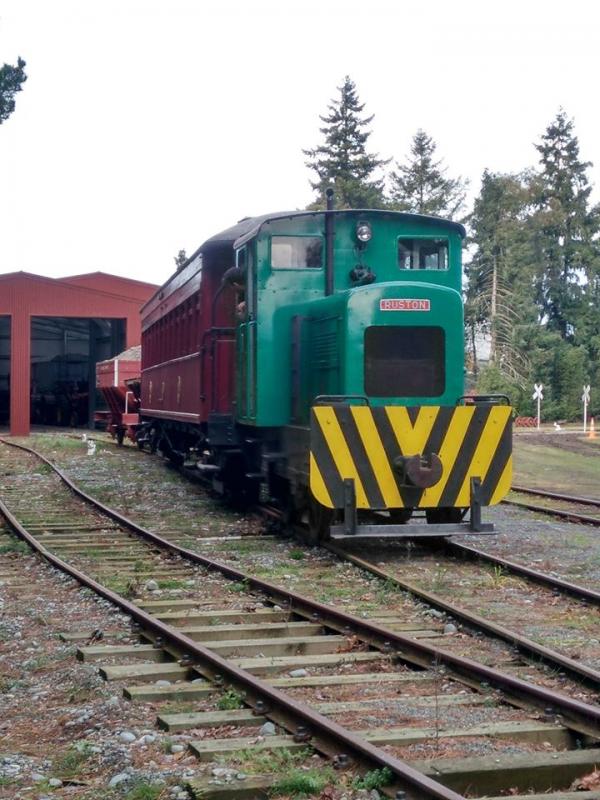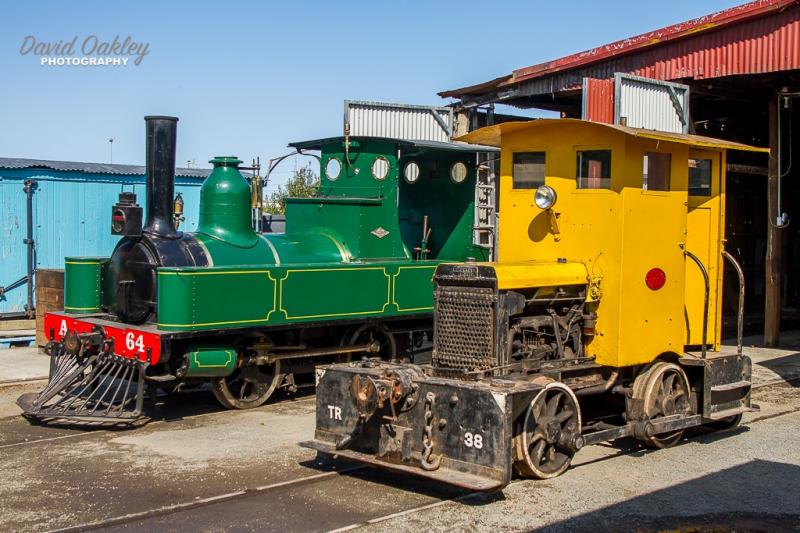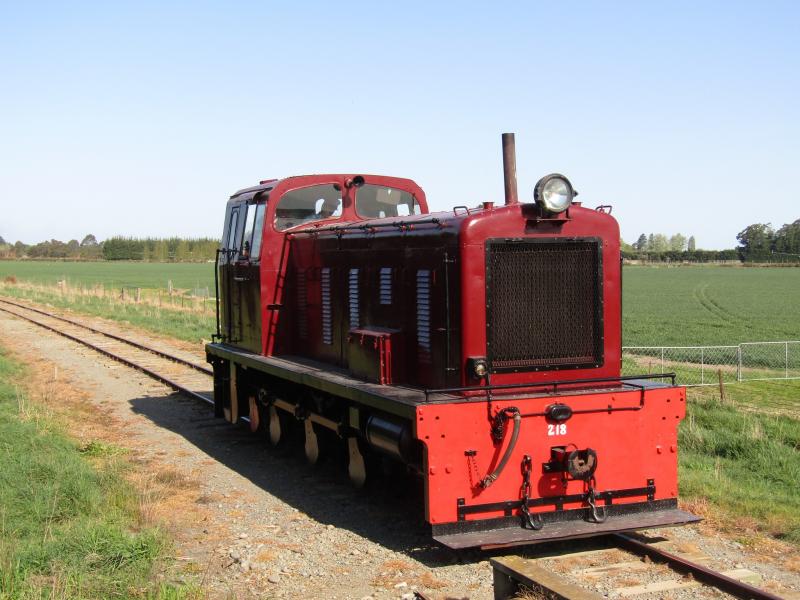A 64 – Dubs & Co.
‘A’ 64 was built in 1873 by Dubs & Co, Glasgow, Scotland. It is a 0-4-0T and was one of the first 3″ 6′ (1067mm) gauged locomotives to operate in New Zealand. This small light-weight (11ton) locomotive performed well in branch line and shunting services. ‘A’ 64 worked with the railways department up until 1890, when it was written off from the railways department. At the time of ‘A’ 64 being written off it was sold to a grain store company in Lyttelton, where it was used to supply steam to various machinery until 1900 when the Canterbury Frozen Meat Co. Ltd. purchased the locomotive, and placed in service as their shunter. The ‘A’ served the C.F.M. Fairton Plant well, being reboilered in 1904 and was finally withdrawn from service with C.F.M. in 1960, though it remained on site as a back-up until 1962.
‘A’ 64 was donated to the Ashburton Steam and Model Engineers Club and was placed in display in the Tinwald Domain. In 1971 The Ashburton Railway and Preservation Society was formed to restore the ‘A’ to working order for use on their newly founded Plains Railway, utilising a small section of the former Mt Somers branch. The ‘A’ is still owned by the Ashburton Steam and Model Engineers Club and is leased to the AR&PS’s Plains Railway. The ‘A’ has been in regular service at The Plains ever since. For many years it continued to display the letters ‘C.F.M.’ on its side water tanks, which had had their rounded ends removed while in service with Canterbury Frozen Meats.
In recent years the ‘A’ has been re-painted into a green livery with yellow lining out, the letters ‘C.F.M.’ were removed from the tank sides, and the rounded end water tanks have been re-instated, and a cowcatcher has also been fitted to the front of the locomotive. The A does still have a rear coal bunker, which is affixed to the back of the cab. This feature is unique amongst the preserved ‘A’ class locomotives as it was not as feature on the ‘A’ class when it was built, it is instead an addition made at some point during its life-time at C.F.M.. It is likely that this bunker was fitted at the same time the original round-ended water tanks were removed.
Dubs ‘A’ 64 carries the builders number of 651, making it New Zealands second oldest operational steam locomotive after The Ferrymead Railway’s (Canterbury Railway Society) ‘F’ 13 of 1872.
K 88 – Rogers Locomotive Works
‘K’ 88, or Washington, was built in 1877 by Rogers Locomotive Works, Paterson, New Jersey. With the builders number of 2454, it is now one of the oldest operational Rogers built locomotives in the world. The orginal order for ‘K’ class 2-4-2 locomotives was for two locomotives only, a second order was placed in 1878 for a further 6, once the original two; ‘K’ 88 Washington, and ‘K’ 87 Lincoln, had dismissed their titles of mere ‘yankee toys’.
Upon arrival from the USA the two ‘K’ locomotives were pushed into service. ‘K’ 88 became the first locomotive to ever haul an express train between the fledgling cities of Christchurch and Dunedin, on New Zealands first ‘Main Trunk Railway’. Soon the expresses became longer and heavier, and more powerful locomotives were required. By 1885 the ‘K’ class had been superseded and was relegated to branch line and secondary work – sometimes seen banking the expresses out of Dunedin. Around the end of the 19th Century, the ‘K’ locomotives – including ‘K’ 88 – got a new lease of life hauling tourist trains from Gore to Kingston, on the shore of Lake Wakitipu. This was the original ‘Kingston Flyer’. ‘K’ 88 continued to race across the Waimea Plains hauling tourists to the Lake until the mid 1920’s, when it was written off. Scrap metal prices at the time were low, so it was decided to use the old engines as flood protection. ‘K’ 88 looked to have no future, until the early 1970’s. After a discussion on the ‘old’ Kingston flyer locomotives, it was remembered that some of them had been placed in the Oreti River as flood protection.
In 1974 the ‘K’ had been uncovered, and was moved to the Plains Railway Museum. On arrival at the museum, after restoration had begun – largely by one man, the late Bob Anderson – it was discovered that this was not just any ‘K’, but ‘K’ 88, the first American Built engine to enter service in New Zealand, and the first locomotive to ever haul an express train between two major cities. In 1982, against all odds, Bob Anderson accomplished his dream, and the Plains Railway drew world-wide attention. In the period up until its boiler failed in 1986, ‘K’ 88 ran a number of trips on the mainline promoting Monteiths, and also starred in the television mini-series of Hanlon. The boiler ‘K’ 88 was restored with was first fitted to the locomotive around 1900 and had greatly deteriorated to ever be of use again.
The ‘K 88 Trust’ was formed to finance the second restoration of the ‘K’. A new boiler was constructed by Lyttleton Engineering. The trust also sourced a new workshop/engine shed for the museum, in a former life this building was a supermarket. The ‘K’ had much work, that couldn’t be carried out in the first restoration, completed during the second restoration. This included the straightening of bent frames from having been rolled into the river.
‘K’ 88 re-entered service in 2002 with an interpretation of its original ‘loud’ livery of 1877. Since being restored ‘K’ 88 has ventured to Dunedin for the Dunedin Station Centenary Celebrations.f
Over the winter of 2012 ‘K’ 88 underwent her first major survey – a ‘ten year inspection’. K88 returned to service a mere 18 weeks after being withdrawn for overhaul, this time painted an interpretation of the original livery.
For the 2022-23 Operating Season, K88 will remain out of Service as a 10 year Inspection takes place.
Ja 1260 – Hillside Workshops
‘Ja’ 1260 was built at Hillside Railway Workshops, Dunedin for the New Zealand Government Railways in 1952. The Ja class was virtually identical to the J class, built by the North British Locomotive works. The main difference was the use of roller bearings on the rods and axles. The ‘J’ and ‘Ja’ classs were referred to as the ‘Greyhounds’ of the New Zealand Railways locomotive fleet. These engines, with drivers measuring a mere 4′ 6″ – not even up to international ‘Freight’ type engines – were capable of 70mph and higher.
The grate area of the ‘Ja’ class is a hand-fired 39sq feet. The “Ja” class in operational order carries 6 tons of coal, and 4000 gallons of water.
‘Ja’ 1260 spent the majority of its working life based in Dunedin, working between Oamaru in the north, and Invercargill in the south. ‘Ja’ 1260 was one of the last steam locomotives to withdrawn from Railways Department service, and was the last steam locomotive to haul a night express out of Dunedin in 1971. It was also the last steam locomotive in service to haul passenger trains out of Christchurch. After its withdrawal ‘Ja’ 1260 was acquired by The Plains Railway and was towed to Ashburton in April 1972 and stored there until February 1973 before being towed to The Plains Railway Museums precinct.
In 2007 The Plains then focused attention on the ‘Ja’ for a return to steam for a starring role in the upcoming Charles Upham film (since cancelled). On the 25th of April 2008 ‘Ja’ 1260’s boiler passed inspection, and officially returned to service.
RM 50 – Vulcan Foundry
During the war years, New Zealand Railways needed a cheaper mode of Transport for light passenger duties, Ten 29.5 ton railcars were ordered from the ‘Vulcan’ Foundry. Only 9 of the 10 ever entered service, the 10th was lost when a German Submarine attacked the transportation ship. In New Zealand Railways service this type of railcar became known by its builders name, and so the word ‘Vulcan’ entered the New Zealand Railways language. The Vulcan railcars are powered by a 6 cylinder Frichs diesel engine developing 250hp, and are capable of running in multiple.
In trials on the 25th October 1940 Vulcan Railcar ‘RM’ 50 set the official New Zealand Railways speed record of 78mp/h, or 125km/h. This record is still standing today, with the railways of the time focusing on a reliable service as opposed to setting speed records.
The Plains Railway acquired ‘RM’ 50 in March 1979, when all the Vulcans in service were withdrawn.
‘RM’ 50 has seen a large amount of service for the Plains Railway, in fact of the entire Plains Railway fleet the Vulcan Railcar has probably run the most mileage in preservation.
‘RM’ 50 can usually be seen running during the summer months at The Plains Railway when the districts fire risk is set at High.
TR 119 – A & G Price Ltd
‘TR’ 119 was built by A & G Price of Thames in 1960, as Price 198. Although being of a similar design to New Zealand Railways ‘TR’ class diesel shunters, Price 198/’TR’ 119 was never in NZR service, and so is not an ‘official’ member of the ‘TR’ class. The number ‘119’ was never carried by any NZR ‘TR’ class locomotive, and so was adopted by Price 198.
The ‘TR’ was built for Kempthorne Prosser & Co. of Hornby Christchurch for shunting their private sidings. When retired from Kempthorn Prosser & Co, in the 1980’s, Price198/’TR’ 119 was donated to the Weka Pass Railway, before coming to The Plains Railway Museum in the 1990’s.
Members of the Plains Railway restored Price 198/’TR’ 119 and in 1997 it was the recepient of a FRONZ award for its restoration.
J & F Howard Industrial Locomotive
This locomotive was constructed by J & F Howard company in England and was one of two imported for the PWD (Public Works Department) in approx. 1930. The Howard Company was liquidated in 1931, so this may be one of the last locomotives to be built there, and is numbered by the builders as 936.
After leaving PWD service this locomotive went on to work the Smithfield Freezing Works in Timaru, before coming to The Plains Railway Museum in 1986.
The sister locomotive to Howard 936 ended its life as a bush locomotive, or ‘lokey’, in the National Park area of the central North Island.
In recent times ‘The Howard’ – as it is commonly referred to at The Plains – has seen most of its exterior body work replaced with new metal.
TR 38 – A & G Price Ltd
‘TR’ 38 was built by A&G Price Ltd of Thames in 1938, and was one of only two of its type. It was New Zealands first Diesel locomotive. Weighing in at only 6.25 tons, it’s 6cylinder Perkins P6 diesel engine develops 56hp and is rated to pull 110tons.
‘TR’ 38 started its life in the Ways and Works department of the NZR in 1938, and was used in construction and maintenance of the North Island Main Trunk Line between Auckland and Frankton, also seeing use in Otahuhu and Dunedin. ‘TR’ 38 was first preserved by the Shanty Town Museum near Greymouth on the South Islands West Coast, before moving to The Plains Railway Museum in February 1982.
DSA 218
Railways Career: DSA 218 initially entered service for the New Zealand Railways in 1953 and built for the Drewry Car Company by the Vulcan Foundry (English Electric). Drewry supplied a total of 20 DSA class locomotives and of those twenty only two were originally allocated to the South Island, DSA’s 218 and 234 – both these locomotives had found their way to Invercargill by 1977 and it presumed DSA 218 remained Invercargill based until the end of her New Zealand Railways Career.
In 1982 DSA 218 was sold to the Ohai Railway Board, who ran their own private railway between Wairio and Ohai in the Southland Region for coal mining purposes. In 1989 the Ohai Railway Board sold DSA 218 to the Oamaru Steam & Rail Society, however after a short stint at their museum the DSA was swapped for the steam locomotive at the Alliance freezing works at Pukeuri, just north of Oamaru. The DSA performed well for the Alliance Works until it was replaced by a larger locomotive in 2007. The DSA was kept as a back-up locomotive and used intermittently until 2010 when it was withdrawn from active service.
In the middle of 2013 The Ashburton Railway & Preservation Society (The Plains Railway) began negotiations for the purchase of DSA 218 after hearing news of its availability. The purchase was agreed to in January of 2014 and the DSA transported by road to The Plains Railway on April 4th 2014.
Restoration of DSA 218 to running order commenced over a period of time, with this entering Operating Service in 2022.

